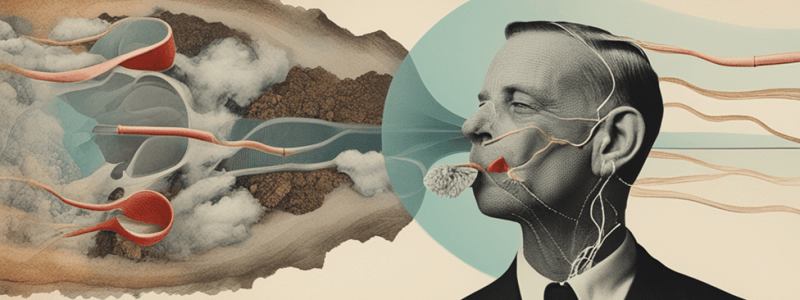Podcast
Questions and Answers
What is the function of the cilia in the nasal cavity during breathing?
What is the function of the cilia in the nasal cavity during breathing?
- Remove larger dust particles
- Filter out smaller dust particles and microbes (correct)
- Purify the air as it enters the windpipe
- Warm and moisten the air
Where does oxygen primarily pass into the blood during the breathing process?
Where does oxygen primarily pass into the blood during the breathing process?
- Bronchioles
- Alveoli (correct)
- Bronchi
- Nostrils
What happens to the carbon dioxide produced by cells throughout the body?
What happens to the carbon dioxide produced by cells throughout the body?
- It is filtered out by mucus in the nasal cavity
- It is expelled through the nostrils
- It reaches the heart where it is pumped to cells
- It is absorbed by the blood and returned to the heart (correct)
How is oxygen transported from the lungs to cells throughout the body?
How is oxygen transported from the lungs to cells throughout the body?
Which part of the body controls the process of breathing?
Which part of the body controls the process of breathing?
What initiates exhalation in the breathing process?
What initiates exhalation in the breathing process?
What happens to air as it passes through the nostrils during inhalation?
What happens to air as it passes through the nostrils during inhalation?
What is the primary role of alveoli in the breathing process?
What is the primary role of alveoli in the breathing process?
How does the diaphragm contribute to exhalation?
How does the diaphragm contribute to exhalation?
What is oxyhemoglobin and where is it formed in the breathing process?
What is oxyhemoglobin and where is it formed in the breathing process?
What is the main function of bronchioles in the respiratory system?
What is the main function of bronchioles in the respiratory system?
Why is mucus important in the breathing process?
Why is mucus important in the breathing process?
Study Notes
- During breathing, two main processes occur: inhalation and exhalation.
- Inhalation begins with the diaphragm moving downward and the sternum outward, creating space in the lungs and allowing air to be sucked in through the nostrils.
- Air passes through nostrils hairs that filter out large dust particles, while mucus and cilia remove smaller dust particles and microbes in the nasal cavity.
- Mucus also warms and moistens the air as it enters the windpipe, where it is further purified.
- Air is divided by bronchi and enters the lungs, where it is further divided by bronchioles and reaches millions of alveoli.
- Alveoli, covered with a large number of blood vessels, only allow oxygen to pass into the blood and form oxyhemoglobin.
- Oxyhemoglobin then reaches the heart and is pumped to cells throughout the body, where oxygen is used for energy generation and carbon dioxide is produced.
- Carbon dioxide is absorbed by the blood and returned to the heart, which pumps it to the lungs for exhalation.
- Exhalation occurs when the diaphragm moves inwards and the sternum moves backward, pressurizing gases to be expelled through the nostrils.
- The process of breathing is controlled by the brain.
Studying That Suits You
Use AI to generate personalized quizzes and flashcards to suit your learning preferences.
Description
This quiz provides an overview of the human respiratory system, focusing on the processes of inhalation and exhalation. It covers how air enters the body, is purified, and exchanged in the lungs to facilitate the transport of oxygen to cells for energy production and removal of carbon dioxide. The importance of the diaphragm, sternum, nasal cavity, bronchi, alveoli, and oxyhemoglobin in this essential process is highlighted.




